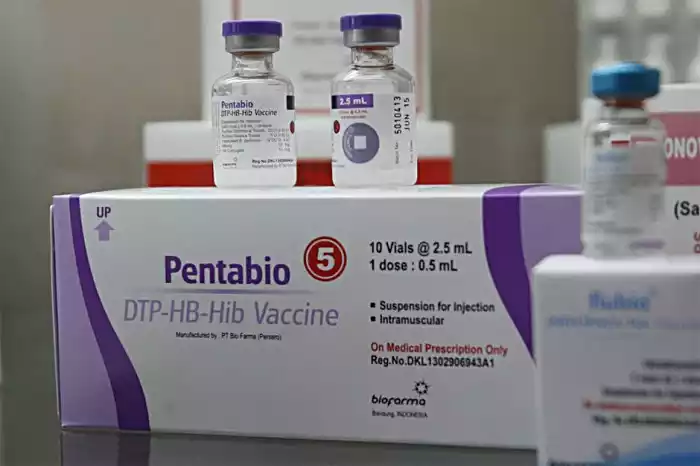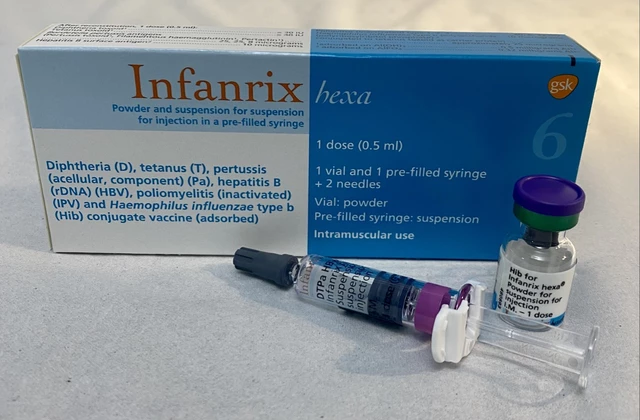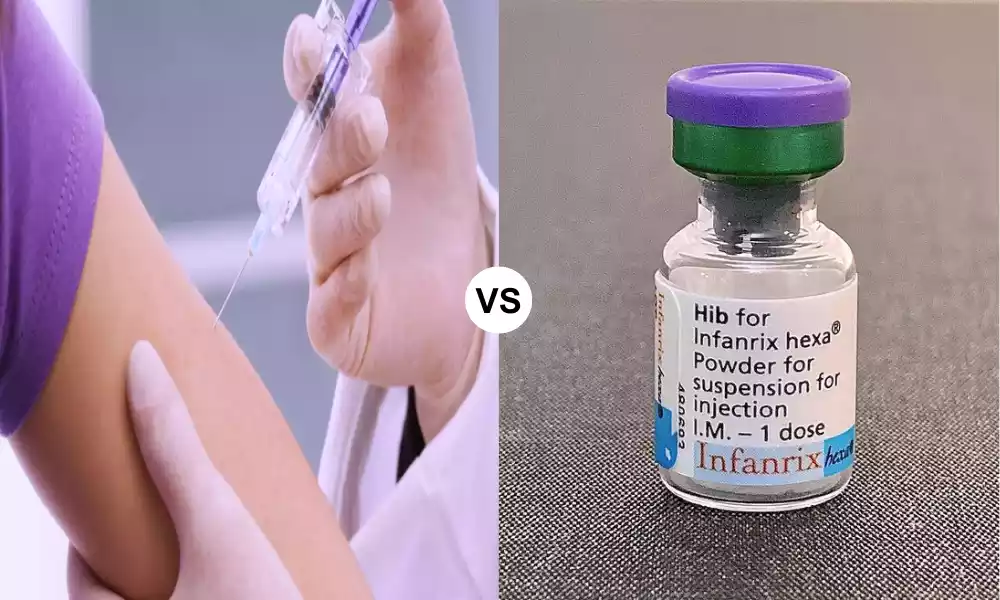Penta and Hexa Vaccine are vital components of many national immunization programs, designed to protect against multiple infectious diseases with a single shot. The Penta vaccine, as the name implies, offers protection against five diseases: diphtheria, tetanus, pertussis (whooping cough), hepatitis B, and Haemophilus influenzae type b (Hib).
The Hexa vaccine offers protection against these same five diseases with the addition of polio. By combining these antigens into one vaccine, it reduces the number of injections a child needs, thereby simplifying vaccination schedules and increasing overall coverage rates.
What is Penta Vaccine?
The Penta vaccine, or pentavalent vaccine, is a combined vaccine that offers protection against five major preventable diseases in one injection.

The diseases covered by the Penta vaccine are:
- Diphtheria: A bacterial infection caused by Corynebacterium diphtheriae, which affects the throat and can lead to severe respiratory difficulties.
- Tetanus (Lockjaw): A bacterial disease caused by the toxin of the Clostridium tetani bacterium. This toxin leads to painful muscle contractions, particularly in the jaw and neck muscles.
- Pertussis (Whooping Cough): A respiratory disease caused by the Bordetella pertussis bacterium. It’s highly contagious and is characterized by severe coughing fits.
- Hepatitis B: A viral infection that targets the liver, leading to both acute and chronic liver diseases. Chronic Hepatitis B can result in liver cirrhosis or liver cancer.
- Haemophilus influenzae type b (Hib): This bacterium can cause various infections, especially severe ones like meningitis, pneumonia, and epiglottitis, predominantly in children.
The Penta vaccine combines these five vaccines into one, streamlining the immunization process for better efficiency and broader coverage, reducing the number of injections a child needs, and ensuring protection against these critical diseases.
Benefits and Protection of Penta Vaccine
The Penta vaccine, also known as the pentavalent vaccine, offers a combination of five vaccines to protect against five major preventable diseases. The benefits and protection it offers are as follows:
- Diphtheria Protection:
- Benefits: Protects against a bacterial infection caused by Corynebacterium diphtheriae that can lead to breathing difficulties, heart failure, and paralysis.
- Protection: By inducing an immune response against the diphtheria toxin, the vaccine prevents the severe complications associated with the disease.
- Tetanus (Lockjaw) Protection:
- Benefits: Provides immunity against a severe neurological condition caused by the Clostridium tetani bacterium, where toxins can cause muscle stiffness and spasms.
- Protection: The vaccine generates an immune response against the tetanus toxin, effectively preventing the onset of the disease after exposure.
- Pertussis (Whooping Cough) Protection:
- Benefits: Guards against a highly contagious respiratory disease caused by the Bordetella pertussis bacterium, characterized by severe coughing fits.
- Protection: The vaccine induces immunity against pertussis, reducing the risk of infection, complications, and the spread of the disease.
- Hepatitis B Protection:
- Benefits: Protects against the Hepatitis B virus, which can lead to liver diseases like cirrhosis and liver cancer.
- Protection: The vaccine fosters the production of antibodies against the Hepatitis B virus, providing long-term immunity and preventing liver complications.
- Haemophilus influenzae type b (Hib) Protection:
- Benefits: Provides protection against various serious conditions caused by the Hib bacterium, like meningitis, pneumonia, and epiglottitis.
- Protection: The vaccine prompts an immune response against Hib, significantly reducing the risk of severe infections, especially in young children.
Overall Benefits of Penta Vaccine:
- Simplified Immunization Schedule: Combining five vaccines into one reduces the number of injections, making the immunization process more efficient and manageable.
- Cost-Effective: Consolidated vaccines can be more cost-effective than administering each vaccine separately.
- Improved Coverage: Fewer shots increase the likelihood of children receiving complete protection, as caregivers are more likely to ensure full vaccination.
- Decreased Mortality and Morbidity: By preventing these major diseases, the pentavalent vaccine plays a significant role in reducing child mortality and morbidity globally.
Remember, as with any vaccine, the benefits in terms of prevention often outweigh the potential minor side effects. Parents and caregivers should always consult with healthcare professionals about the vaccination schedule appropriate for their children.
What is the Hexa Vaccine?
The Hexa vaccine, also known as the hexavalent vaccine, is a combined vaccine that offers protection against six major preventable diseases in one injection.

The diseases covered by the Hexa vaccine are:
- Diphtheria: A serious bacterial infection affecting the mucous membranes of the throat and nose.
- Tetanus (Lockjaw): A serious bacterial disease that affects the nervous system, leading to painful muscle contractions.
- Pertussis (Whooping Cough): A highly contagious respiratory disease caused by the Bordetella pertussis bacterium.
- Hepatitis B: A viral infection that attacks the liver and can lead to both acute and chronic diseases.
- Haemophilus influenzae type b (Hib): A bacterium that can cause a range of infections, particularly in children, from mild ear infections to severe diseases like meningitis.
- Polio: A debilitating viral infection that can lead to paralysis in some cases.
By providing immunity against these six diseases, the hexavalent vaccine is crucial in pediatric immunization schedules, aiming to protect children from these illnesses early in life. Its combined nature means fewer injections, making the immunization process more efficient and manageable for healthcare providers and less distressing for children and their caregivers.
Advantages of Hexa Vaccine
The Hexa vaccine, or hexavalent vaccine, offers protection against six major preventable diseases in a single injection. The advantages of using the Hexa vaccine include:
- Comprehensive Protection: The Hexa vaccine covers six diseases, namely Diphtheria, Tetanus, Pertussis (Whooping Cough), Hepatitis B, Haemophilus influenzae type b (Hib), and Polio. This broad spectrum of protection means that children are safeguarded against several severe and potentially fatal diseases with just one shot.
- Simplified Immunization Schedule: By combining six vaccines into one, the Hexa vaccine reduces the number of injections a child needs. This simplification is beneficial for healthcare systems, reducing the logistical challenges of storing and administering multiple vaccines.
- Increased Compliance: Fewer injections mean increased compliance from parents and caregivers. It’s easier for parents to adhere to vaccination schedules when fewer visits to healthcare facilities are required.
- Reduced Pain and Distress: Minimizing the number of shots decreases the pain and distress for infants and children, making the vaccination process smoother and less traumatic for both the child and the caregivers.
- Cost-Effective: Administering a single vaccine that protects against six diseases can be more cost-effective than giving each vaccine separately. It can lead to savings in terms of storage, transportation, and administration costs.
- Better Vaccine Coverage: By consolidating vaccines, there’s a higher likelihood that children will receive protection against all the included diseases. This comprehensive coverage is essential for public health, reducing outbreaks and the spread of preventable diseases.
- Decrease in Vaccine-Preventable Diseases: The wider coverage and increased compliance ensure that a larger segment of the population is protected, leading to herd immunity and a significant reduction in the prevalence of these diseases in the community.
- Safety and Efficacy: Hexavalent vaccines undergo rigorous testing and are found to be as safe and effective as individual or lesser combined vaccines.
The Hexa vaccine offers a streamlined approach to immunization, providing comprehensive protection while ensuring better compliance and reduced logistical challenges. As always, it’s essential for parents and caregivers to discuss with healthcare professionals to understand the best vaccination strategies for their children.
Comparison Table of Penta and Hexa Vaccine
Here’s a comparison table of the Penta and Hexa vaccines:
| Feature | Penta Vaccine | Hexa Vaccine |
|---|---|---|
| Number of Diseases Covered | 5 | 6 |
| Diseases Covered | 1. Diphtheria
2. Tetanus 3. Pertussis (Whooping Cough) 4. Hepatitis B 5. Haemophilus influenzae type b (Hib) |
1. Diphtheria
2. Tetanus 3. Pertussis (Whooping Cough) 4. Hepatitis B 5. Haemophilus influenzae type b (Hib) 6. Polio |
| Number of Injections | 1 (combines 5 vaccines) | 1 (combines 6 vaccines) |
| Benefits | Simplified immunization, reduced injections, cost-effectiveness, comprehensive protection | All benefits of Penta plus protection against Polio and further simplified immunization. |
| Primary Use | Pediatric immunization against 5 major diseases | Pediatric immunization against 6 major diseases |
This table provides a straightforward comparison between the two vaccines. The main difference is the addition of the Polio vaccine in the Hexa vaccine. Both vaccines are vital in providing early life protection against several diseases.
How are these vaccines administered?
Both the Penta (pentavalent) and Hexa (hexavalent) vaccines are administered as intramuscular injections. Here’s how they are typically administered:
Penta Vaccine (Pentavalent Vaccine):
- Route: Intramuscular (IM).
- Site: The anterolateral aspect of the mid-thigh (vastus lateralis muscle) is the preferred site in infants. The deltoid muscle of the arm can be used in older children.
- Schedule: The administration schedule might differ based on regional guidelines, but a common schedule involves three doses. The World Health Organization (WHO) recommends the first dose at 6 weeks of age, followed by the second dose at 10 weeks, and the third dose at 14 weeks. Some countries might use different schedules, so it’s essential to refer to local immunization guidelines.
Hexa Vaccine (Hexavalent Vaccine):
- Route: Intramuscular (IM).
- Site: Similar to the Penta vaccine, the anterolateral aspect of the mid-thigh is the preferred site in infants, with the deltoid muscle of the arm being an option for older children.
- Schedule: The Hexa vaccine typically follows a schedule similar to the Penta vaccine. It’s usually given as a primary series of three doses in infants, with the first dose often recommended at 6 weeks of age, followed by subsequent doses spaced at intervals, such as at 10 weeks and 14 weeks. A booster might be given in the second year of life, depending on local guidelines.
For both vaccines:
- It’s crucial to ensure the vaccine doesn’t enter blood vessels, so aspiration (pulling back on the syringe to check for blood) before injection might be practiced in certain regions, although the need for aspiration is debated among experts.
- The vaccines should be stored as per the manufacturer’s guidelines, typically in a cold chain to maintain their efficacy.
- Parents should be informed about potential side effects, which are generally mild, like pain at the injection site, mild fever, or irritability.
- It’s important always to consult with healthcare professionals regarding the vaccines’ administration and to rely on local or regional immunization guidelines and schedules.
Potential Side Effects and Precautions
The Penta and Hexa vaccines are combination vaccines given to infants and children to protect against multiple diseases. As with any medical intervention, there can be potential side effects, although the vast majority are mild and transient. Here’s a brief overview:
Potential Side Effects:
- Common Mild Side Effects:
- Pain, redness, or swelling at the injection site.
- Mild fever.
- Irritability or fussiness.
- Fatigue or drowsiness.
- Loss of appetite.
- Less Common Side Effects:
- Vomiting.
- Diarrhea.
- Rare Side Effects:
- Allergic reactions: These are very rare but can include difficulty breathing, hives, or swelling around the eyes or lips. Immediate medical attention is necessary.
- High fever.
- Persistent crying or inconsolable crying for a few hours.
- Seizures or convulsions (often associated with fever).
- Hypotonic-hyporesponsive episode (HHE), where the child becomes pale, limp, and less responsive. This is rare and usually resolves without treatment but should be reported.
Precautions:
- Existing Medical Conditions: Always inform the healthcare provider if your child is sick or has any existing medical conditions before receiving the vaccine.
- Allergies: If the child has had an allergic reaction to a previous dose of the vaccine or any of its components, it’s crucial to inform the healthcare provider.
- Post-vaccination monitoring: After the vaccine is administered, it’s a good practice to remain at the healthcare facility for about 15 minutes to monitor for any immediate allergic reactions.
- Management of side effects: For common side effects like pain or fever, over-the-counter pain relievers like paracetamol can be given, but always consult with a healthcare professional regarding dosages and suitability.
- Follow-up doses: It’s important to adhere to the vaccination schedule for follow-up doses to ensure optimal protection.
Always consult with healthcare professionals about any concerns related to vaccines. They can provide guidance tailored to individual situations and ensure that the child receives the best possible care.
The Global Impact of Penta and Hexa Vaccine
The Penta and Hexa vaccines have had a profound global impact on public health, particularly in reducing morbidity and mortality among infants and children. Here’s a brief overview of their global significance:
- Reduction in Disease Burden:
- Diphtheria, Tetanus, and Pertussis (whooping cough): These diseases once claimed the lives of thousands of children annually. The inclusion of the vaccine against these diseases in the Penta and Hexa formulations has led to significant reductions in the incidence of these illnesses.
- Hepatitis B: A viral infection that can lead to liver disease and liver cancer. Its inclusion in these vaccines means children get protection from this virus from infancy.
- Haemophilus influenzae type b (Hib): Before widespread vaccination, Hib was a leading cause of bacterial meningitis. The vaccine has significantly reduced cases globally.
- Polio (Hexa vaccine): A crippling and potentially deadly infectious disease. The inclusion in the Hexa vaccine aids global efforts to eradicate polio.
- Cost-Effectiveness and Efficiency:
- Combination vaccines like Penta and Hexa reduce the number of shots a child needs, making it more efficient for healthcare systems and more convenient for parents and caregivers.
- The reduced number of shots can lead to better vaccination compliance and coverage, ensuring more children are protected.
- Support from Global Health Organizations:
- Organizations like the World Health Organization (WHO), Gavi, the Vaccine Alliance, and UNICEF have been instrumental in supporting and promoting the use of these vaccines, especially in low-income countries.
- Their efforts have ensured that even children in the poorest and most remote areas have access to these life-saving vaccines.
- Strengthening of Healthcare Systems:
- The push to deliver these vaccines has led to strengthening the cold chain infrastructure, which is vital for vaccine storage and delivery.
- Regular vaccine drives and initiatives have also ensured better monitoring of vaccine coverage and disease surveillance.
- Social and Economic Impact:
- Healthy children mean fewer hospital visits and less financial strain on families and healthcare systems.
- In the long term, reducing the incidence of these diseases means a healthier workforce, leading to potential economic growth and societal development.
The Penta and Hexa vaccines have not only directly saved countless lives but have also played a role in the broader strengthening and development of global healthcare infrastructure, economies, and societies.
Conclusion
The Penta and Hexa vaccines are essential combination vaccines designed to protect infants and young children from multiple life-threatening diseases simultaneously. The Penta vaccine guards against five diseases: diphtheria, tetanus, whooping cough (pertussis), hepatitis B, and Haemophilus influenzae type b (Hib). On the other hand, the Hexa vaccine offers protection against six diseases, adding polio to the list covered by the Penta vaccine.
These vaccines are vital components of childhood immunization schedules, offering efficient and safe protection against diseases that, in the past, have resulted in significant morbidity and mortality. It’s crucial to administer these vaccines to ensure individual and community health protection.



